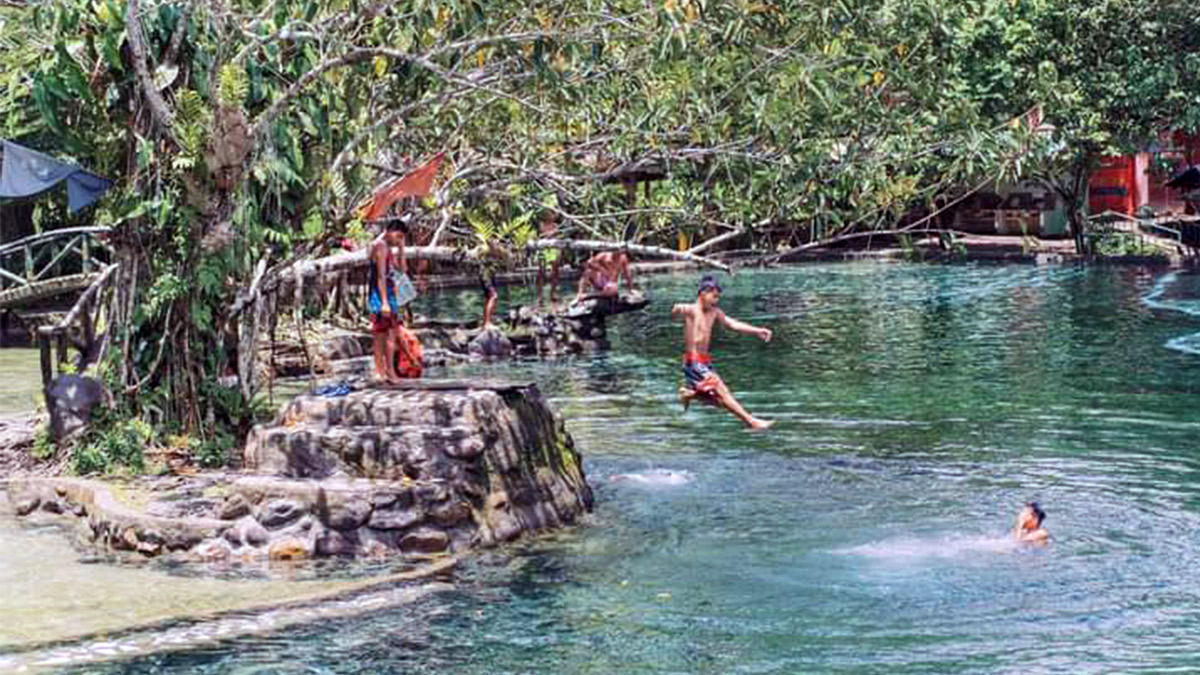
COOL WATERS The cold spring pools in Mahayag, Zamboanga del Sur, used to be avoided by residents because of communist rebels roaming the area. It is now home to Mabanag Spring Resort, shown in this undated photo, frequented by locals since last year and is now being promoted as a safe destination for leisure travelers. PHOTO COURTESY OF MT. MALINDANG CROSS-BORDER TOURISM
SERGIO OSMEÑA, ZAMBOANGA DEL NORTE, Philippines — The Malindang mountain range, which used to be the site of countless battles between government troops and communist New People’s Army (NPA) rebels, is now being promoted as a tourist destination.
After government forces gained the upper hand in the long-drawn war against communist rebels who used to control the area, resort owners formed themselves into a consortium called Mt. Malindang Cross-Border Tourism (MMCT) to invest and develop tourism sites on Mt. Malindang, a mountain range that sits along the border of the provinces of Zamboanga del Norte, Zamboanga del Sur and Misamis Occidental, said lawyer Orlando Salatandre Jr., president of MMCT, as the group celebrated its first anniversary on Saturday.
Although Zamboanga del Norte still remained among the poorest provinces in the country, Salatandre said they wanted to share with people in the communities the benefits of tourism by making them part of the tourism activities in the area.
READ: Alleged NPA leader killed in Zamboanga del Sur clash
Part of the plan, for instance, is to train motorcycle (“habal-habal”) drivers in the area to be more tourist-friendly so that they could also be hired as guides and for other services catering to tourists, said Salatandre.
Among the tourism sites operating in the three provinces are agritourism farms, parks and restaurants, waterfalls, mountain views, and lakes, offering tourists experiences unique to Mt. Malindang.
Most of these tourism destinations were already developed at the height of the COVID-19 pandemic but they were only aggressively promoted by the resort owners after they formed the consortium last year, Salatandre added.
READ: Informer gets P1-million bounty for tip on NPA in Zamboanga del Sur
Insurgency-free
On Saturday, as the MMCT celebrated its first anniversary, they gathered resort owners, partner stakeholders, the military and members of the Philippine National Police at the municipal gym here.
Zamboanga del Norte has been declared “insurgency-free” in the last three years and recently, in his visit here, Armed Forces of the Philippines Chief of Staff Gen. Romeo Brawner Jr. lauded soldiers and local officials for the dismantling of the NPA’s Western Mindanao Regional Party Committee (WMRPC) with the death of Aprecia Alvarez Rosette, alias Bambam, its leader.
Rosette was killed during a military combat operation in Malagalad village of Dumingag town, Zamboanga del Sur, on Feb. 27 this year.
According to the military, the operation of the WMRPC covered the Zamboanga Peninsula region and the province of Misamis Occidental.
‘Guardians’
The military considered the hinterlands of Mt. Malindang as the former “lair” of communist rebels but the construction of new roads and the coming in of tourism investors opened up the area for development.
Both the military and the police pledged their commitment to serve as “guardians” to the natural resources of Mt. Malindang while the Department of Tourism (DOT) helped give tourism training to policemen who would be deployed to different tourism destinations in the province.
Dara May Cataluña, director of the DOT in the Zamboanga Peninsula, said her office trained tourist police to be deployed in different destinations in Zamboanga del Norte and would soon start to give similar training to barangay “tanods” (village watchmen) and barangay officials to prepare them for the arrival of tourists in their areas.
Cataluña also said that the DOT also acknowledged the Subanen Indigenous peoples (IP) as among the IPs living in Zamboanga Peninsula and in Isabela City in Basilan province.
“We have to establish that we have an identity just like the other regions and provinces known for the tribes in their area. They have to be recognized and honored for being the first tribe to live [on] the Peninsula,” she said.